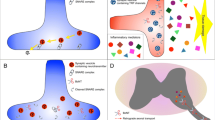Abstract.
Background:
Botulinum neurotoxin (BoNT) is used to treat various neurological disorders associated with pathologically increased muscle tone. Botulinum toxin inhibits the release of the neurotransmitter acetylcholine at the neuromuscular junction thereby inhibiting striatal muscle contractions. Besides the reduction in muscle tone BoNT tends to reduce pain in pain syndromes associated with muscle spasm. In addition, BoNT has been proposed as an analgesic, suggesting alternative non-cholinergic mechanisms of action.
Surprisingly, BoNT was reported as a potential treatment for tensiontype headache and migraine—both primary headache syndromes without an apparent muscular component—however, varying responses to BoNT have been found, overall without sufficient evidence for a general treatment.
In this systematic review we set out to clarify the efficacy and safety of BoNT in the treatment of rare head and neck pain syndromes (e. g. cervicogenic headache, chronic paroxysmal hemicrania, cluster headache, trigeminal neuralgia, temporomandibular disorders, cervical dystonia and whiplash injuries).
Objectives:
To assess the analgesic efficacy and safety of botulinum toxins versus other medicines, placebo or no treatment in rare head and neck pain syndromes.
Search strategy:
We searched the bibliographic databases MEDLINE, EMBASE and PASCAL Biomed to May 2003. We also reviewed the reference lists from identified articles including reviews and meta-analyses of treatment studies. Furthermore we searched booklets of scientific congresses in the field of neurology for potentially relevant studies. Additional reports were identified from the reference list of the retrieved papers, and by contacting experts in the field.
Selection criteria:
Randomized controlled trials (RCTs) with any dose of BoNT for rare head and neck pain syndromes, describing subjective pain assessment as either the primary or a secondary outcome, were included in this review.
Data collection and analysis:
All trials were quality scored and two independent reviewers extracted data. Results were compared for differences, and discrepancies were resolved by discussion.
Main results:
Fourteen RCTs of BoNT in cervical dystonia were included in this review. All except one showed significant pain relief following BoNT treatment compared to placebo. Studies providing dichotomous outcome data were pooled using the Peto method. The overall effect was found to be highly significant (OR 4.795 [95% CI 5.551–6.473]). For cervicogenic headache, two RCTs—one positive study and one negative study—were included. Two studies addressing chronic neck pain were included in this review. Both studies did not reveal significant effects. Furthermore, one small trial (N = 15 patients) focussing BoNT in temporomandibular disorders was included,without demonstrating significant effectiveness but a high proportion of patients lost to follow-up and a high rate of adverse effects. For the use of BoNT in cluster headache, chronic paroxysmal hemicrania and trigeminal neuralgia no RCTs were identified.
Adverse effects (AEs) were found to be mild to moderate and dose-dependent. They were summarized where possible, irrespective of the formulation used and condition treated (OR = 5.066 [95% CI 2.770–9.265], number-needed-to-harm (NNH) = 5.5 [range 4.4–17]).
Reviewers’ conclusions:
There is convincing evidence for the effectiveness of BoNT in the treatment of pain associated with cervical dystonia. Due to the frequent adverse effects predominantly observed with higher doses, the trade off in risk and benefit should be carefully considered in each case. For all other rare head and neck pain syndromes we found no RCTs (cluster headache, chronic paroxysmal hemicrania, trigeminal neuralgia) and only a few small sized trials (cervicogenic headache, chronic neck pain, temporomandibular disorders). We were therefore unable to draw any definite conclusions.
Similar content being viewed by others
Author information
Authors and Affiliations
Corresponding author
Rights and permissions
About this article
Cite this article
Sycha, T., Kranz, G., Auff, E. et al. Botulinum toxin in the treatment of rare head and neck pain syndromes: a systematic review of the literature. J Neurol 251 (Suppl 1), i19–i30 (2004). https://doi.org/10.1007/s00415-004-1106-8
Issue Date:
DOI: https://doi.org/10.1007/s00415-004-1106-8




